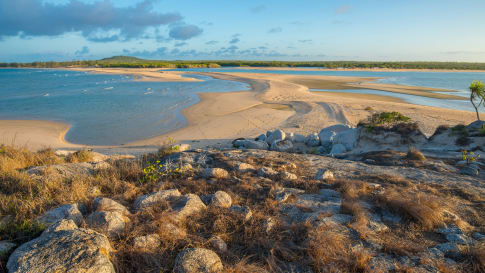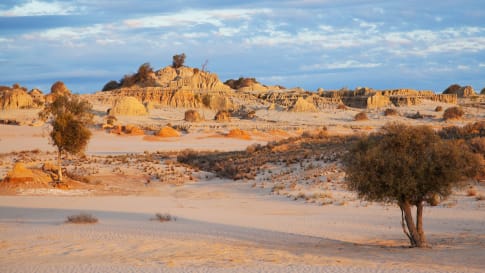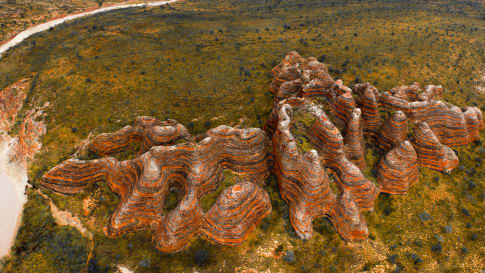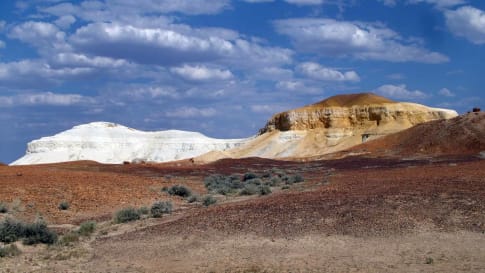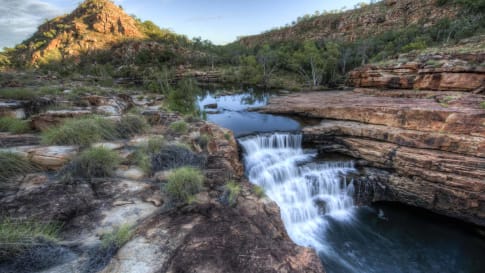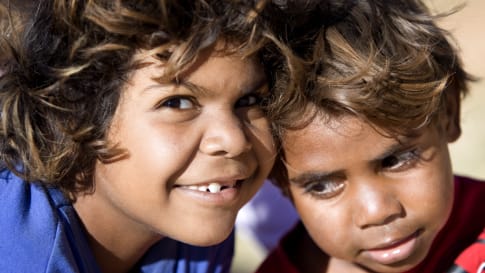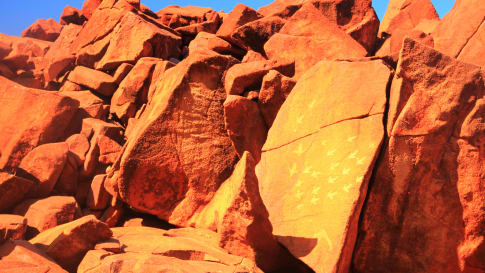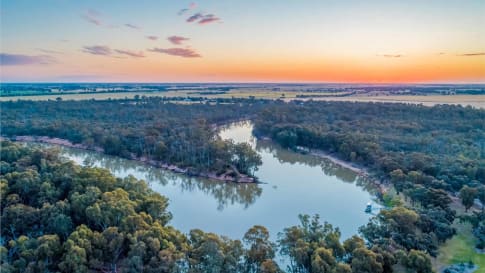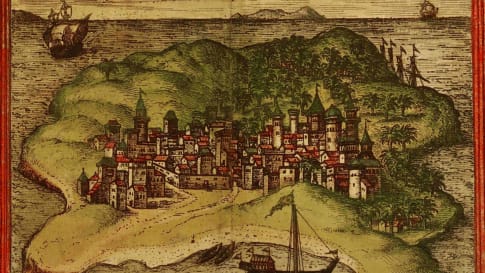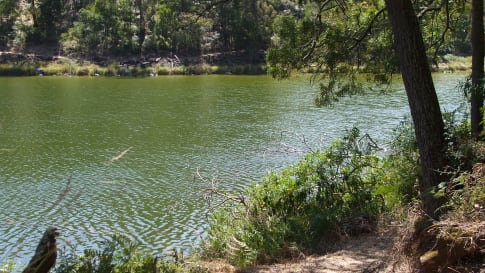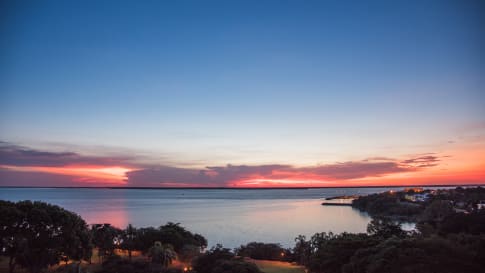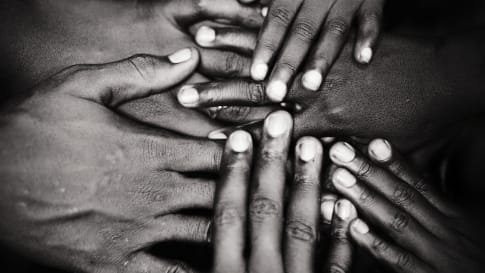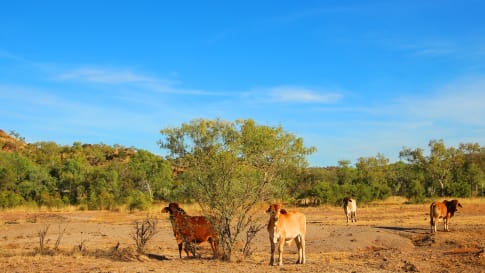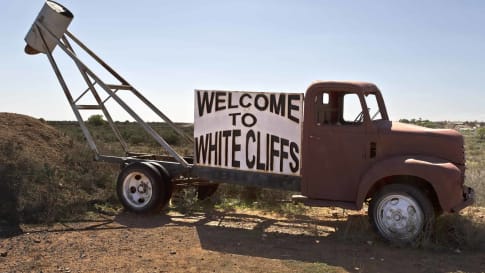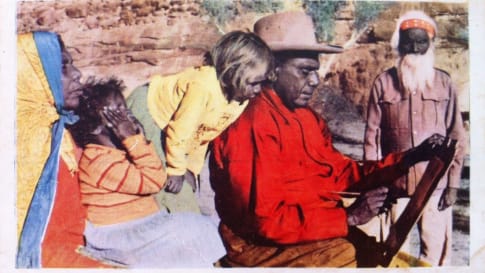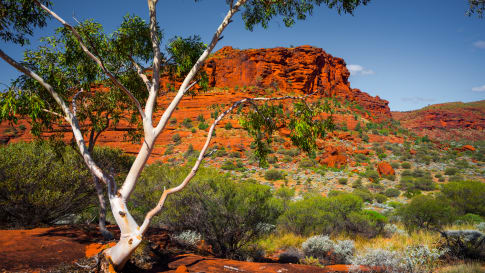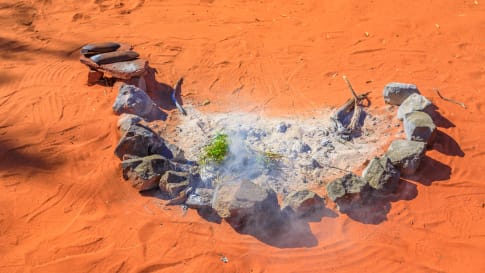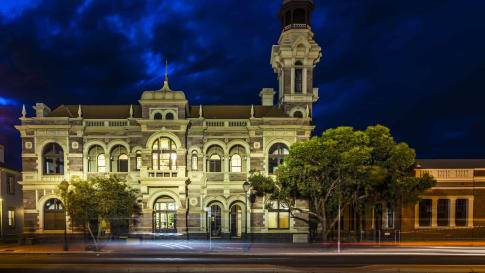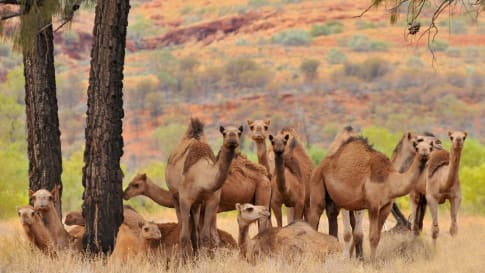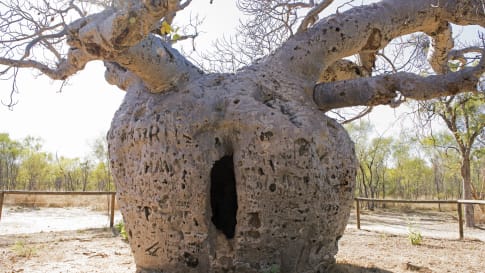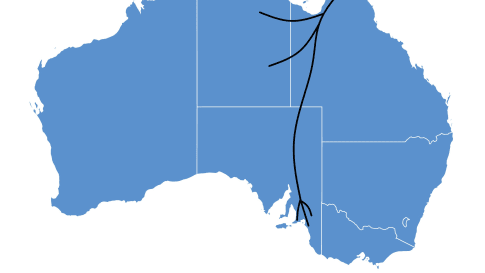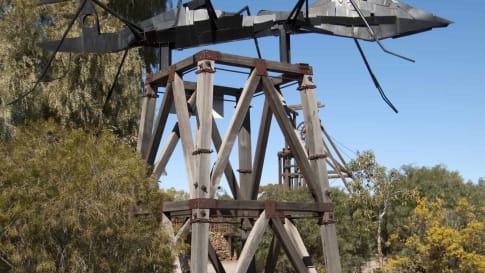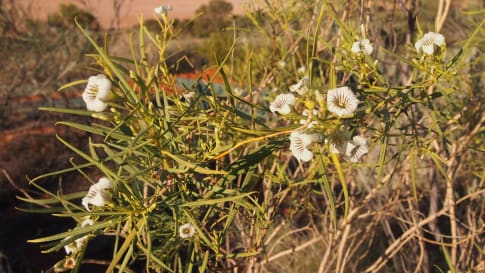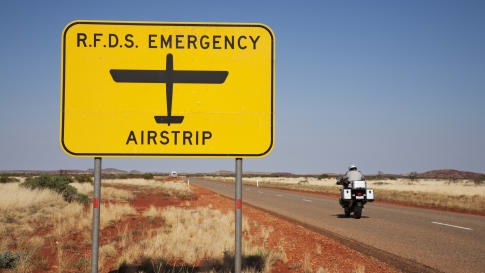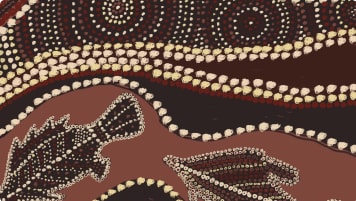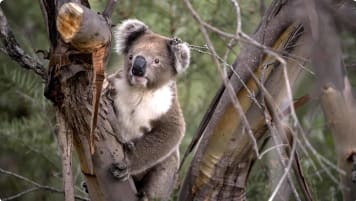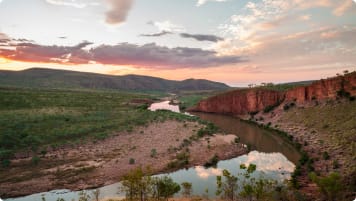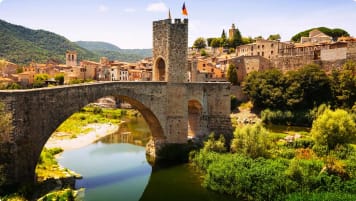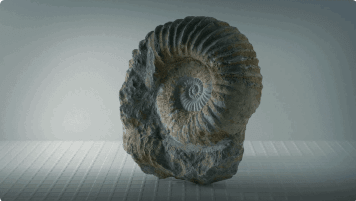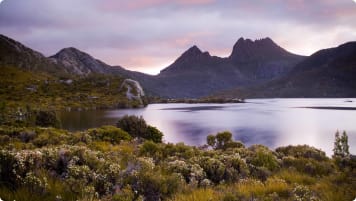Long tour of Australia for a small group
Small group tour for senior couples and solo travellers touring Australia. Travelling through the outback and visiting many of the famous sights as well as off the beaten track locations. Learn about the history of the people who explored the deserts, from indigenous communities to Europeans, as well as Burke and Wills, visit White Cliffs, Marree and far north Kakadu and the Kimberley.
From A$48,995AUD
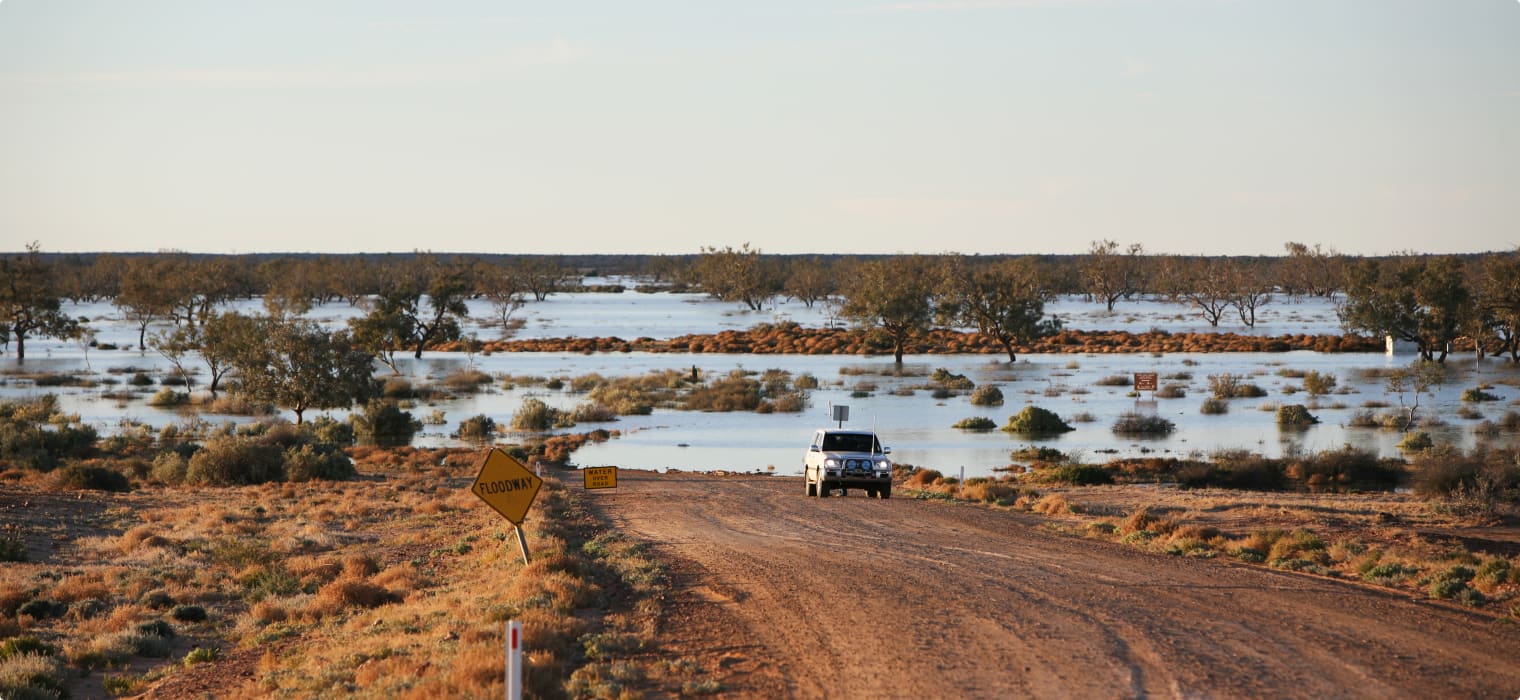
Highlights
- 1. Learn about the history of Broken hill and Silverton.
- 2. Explore the Kimberley including the Bungles.
- 3. Learn abut the wildflowers of Southern coast of WA.
- 4. Spend time in Arnhem land with the local community.
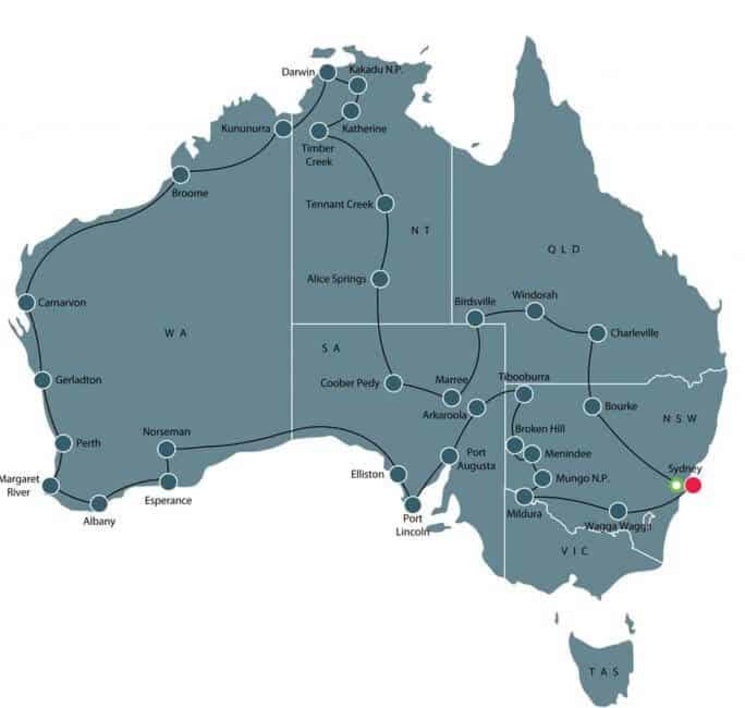
Departure Dates
| Departure Date | Price |
|---|---|
| 24 March 2025 Ends 27 May 2025 • 65 days A$48,995 Twin A$55,510 Single Available | Selected |
Long tour of Australia for a small group
Travel is a challenge, when you leave the major cities of Sydney, Melbourne or Brisbane on a trip by car or an escorted tour by coach, the sheer scale of the outback Australia begins to reveal itself as the journey unfolds. This 65 day tour across Australia seeks to introduce and further enhance the traveller appreciation of this unique land, from the Trading routes and songlines of the Aboriginal communities and today's contemporary art to the colonial explorers such Grey, Sturt or Stuart or Burke and Wills and Pastoralists such as Kidman, the Duracks or Forrest to the wildlife and landscapes including the river systems this program provides a lot to the traveller. Odyssey has prepared a small group tour that covers much of central, western and Southern Australia to Victoria. The program could have gone on and on, we have sought to offer a program that is comfortable and introduces to the country allowing you should you with to explore areas of interest further at your leisure and we trust with Odyssey. The scheduled departures are in the dry season, the days are dry and in the low 20's, the nights in the centra and the desert are cold, less than 10 degrees Celsius. But it is a reasonable climate for travel with high sunshine hours. Each departure has something, whether the end of the wet season and the desert greens continue or the wildflower season of the Southern coast of Western Australia for example. The scale often unrecognised on the road, when travelling through the outback, this journey is an adventure, that will run for more than a few days. A road trip that requires planning and destinations selected in advance. The scale of the outback and the hidden history can often be missed on a journey in a car. When you travel as part of a small group tour of Australia with Odyssey, your tour guide, whether on Kangaroo Island, in the Northern territory or on a day tour within Western Australia deep in the Kimberley, will be sharing stories with you about the Australian wildlife and some of world’s most beautiful dreamtime stories from the indigenous Australian community as you journey through the outback at time immersed in Aboriginal culture. For you our client, this long tour of Australia small group tour seeks to create a program of learning as you travel. That learning with your program leader is about the history, the landscapes and biodiversity and then the culture of the place. This long tour provides a great platform with 3 departures a year.Travel in a business class style seat in a premium coach for a maximum of 16 travellers
The coach is a purpose built, 21 seater, complete with single row business style reclining leather chair seating, complete with USB ports, and folding dining table, wifi (when available), on board Kitchenette, complete with espresso machine and tea making facilities, microwave and fridge as well entertainment system and a on board toilet. Each traveller really does have their own semi private space to enjoy the road less travelled from. Travelling into the outback of Australia means a greater responsibility to the group, so this coach tour is also equipped with all that is required to manage all the emergency scenarios we could envisage with satellite communication, emergency flares, and winches to tow the coach out if stuck on a unsealed road should an unfortunate situation arise. These are small group tours of Australia within our peace of mind policy for a group of up to 16 travellers. We have selected this kneeling coach for ease of access for mature and senior travellers to get on and off the vehicle.A truly Australian tour for mature couples and solo travellers.
This is not an adventure Australia tour but it is a wildlife Australia tours, a travel experience across Australia. Coach tours in Australia for seniors that track the stunning scenery of the great Australian bight or the wildflowers of Western Australia.
This is a fascinating country and this collection of a discovery Australia escorted tour(s) will seek to show how its geographical isolation has allowed for an incredible biodiversity record unlike any of other place on the planet, in its Australian wildlife from the monotreme, to the Kangaroo, platypus, wombat, quokka, echidna and koala, to its plant diversity expressed in the wildflowers of Western Australia or its desert. Not all our tours are wildlife Australia tours, but once tours of Australia leave the built up environment then there will be a wildlife experience at some time on your Australia vacation.
The Aborigines have been present here for some 80,000 years+. They developed not only incredible storytelling to pass on from generation to generation but had the ability to manage world’s most arid continent on a sustainable basis. The Aboriginal people also represented their life and understanding through rock art and painting which we explore in the Kimberley region also on these Western Australia tours. In South Australia, Europeans made their mark in the Flinders ranges, but long after geologic processes have commenced. Wilpena Pound represents the stumps of Mountains once believed to be as tall as the Himalayas. Coober Pedy yielded opals to miners as other British settlers sought to develop Agriculture, train lines and the telegraph through the Flinders ranges.
These Australian outback small group tour programs also explore and learn about the importance of the National park network and its unique endemic biodiversity. And finally the Australian outback tours itinerary means we stop at places of importance in the European history of Australia, primarily the outback adventure that was the catastrophic Burke and Wills expedition out of Melbourne and the mapping work of Charles Sturt and his search for the "inland sea". By the time this guided tour returns to Broken Hill our appreciation and understanding of this part of the central outback Australia will have been extended as a result from what we have heard from the expert custodians in Aboriginal culture in the indigenous community and local guides who have a perspective and respect for the European history of the last two centuries.
Because of the intensity of the environment that these outback Australia tours travels through, Odyssey Traveller offers just a maximum of three departures a year in the Spring and Autumn.
Articles about Australia published by Odyssey Traveller:
- The Kimberley: A Definitive Guide
- Uncovering the Ancient History of Aboriginal Australia
- Aboriginal Land Use in the Mallee
- Understanding Aboriginal Aquaculture
- Mallee and Mulga: Two Iconic and Typically Inland Australian Plant Communities (By Dr. Sandy Scott).
- The Australian Outback: A Definitive Guide
For all the articles Odyssey Traveller has published for mature aged and senior travellers, click through on this link.
External articles to assist you on your tour
Gallery
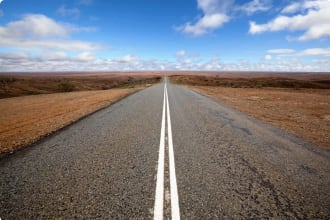
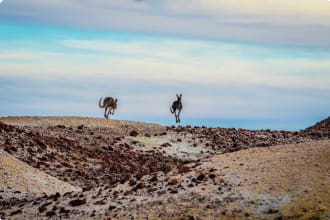
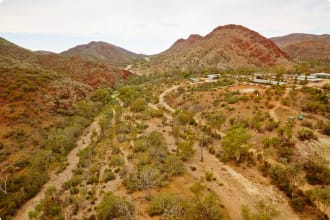

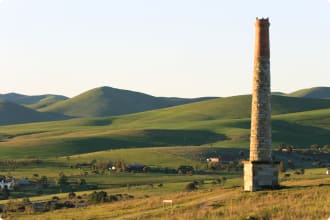
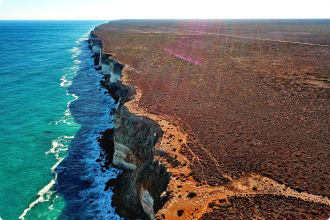
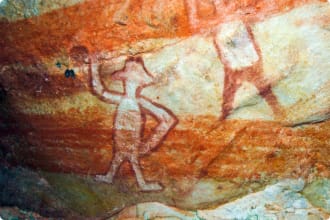


Itinerary
65 days
Day 1: Sydney
Accommodation: Sydney - Park Royal Paramatta or equivalent
The group comes together in the late afternoon for a tour briefing and introductions.
There is a group welcome dinner this evening.
Day 2-3: Bourke
Accommodation: The Riverside motel or similar
Today, we depart from Sydney very early, (hence our selection of hotel for the first night) after breakfast we head to Dubbo, via Mudgee or Orange along the Mitchell Highway via Narromine and Nyngan. In the afternoon we’ll continue west to Bourke where we’ll spend the next two nights.
Dinner tonight will be in a local restaurant.
Bourke today is a town with an outback spirit, on the edge of the wilderness, and with a great sense of Australian adventure in its historical, cultural, and geographic significance on the Darling river
In the morning of day three, the group spends time in Brewarrina, we stop off to see one of the world’s oldest surviving man-made structures: the Brewarrina Fish Traps. The Ngemba people are the custodians of the fish traps, a complex aquaculture network estimated to be over 40, 000 years old. An elaborate network of rock weirs and pools form a series of complex dry-stone walls and holding ponds, stretching for around half a kilometre along the Barwon riverbed. For the Aboriginal people of western and northern New South Wales, the fish traps and surrounds are extremely significant for their spiritual, cultural, traditional and symbolic meanings. The creation of the fish traps, and the laws governing their use, helped shape the spiritual, political, social, ceremonial and trade relationships between Aboriginal groups from across the greater landscape. Brewarrina was one of the great Aboriginal meeting places of eastern Australia.
In the afternoon we return to Bourke for a walking tour of the town to learn more about its history.
Day 4 & 5: Charleville
Accommodation: Hotel Corones or similar
This small group tour spends 2 nights in Charleville. Whilst here the group have the opportunity to go star and planet gazing, take time to tour the historic town and understand the value of wool to a town like Charleville in the early 20th century period. Take a private tour of the heritage listed Hotel Corones with a rags to riches story linked to Qantas, Greek islands, Brisbane and Sydney.
Today we explore the city and its history, we will visit the Charleville Historic House Museum and its building that dates back to 1887. We’ll also learn more about the time the local airport became temporarily part of the USA in 1942 on a secret WWII tour. In the evening we will star gaze at the magnificent outback sky at the Charleville Cosmos Centre & Observatory.
Day 6: Windorah
Accommodation: Windorah; Western Star Hotel or equivalent
We continue our journey west to Windorah, located in the Far West region of Queensland, about 500km from Charleville. This small town has a population of just 80 people.
Windorah’s main attraction is Cooper’s Creek, located just outside the township. Here’s the only place where two rivers, the Thomson & Barcoo, join to form a creek. Another attraction in the area are the amazing Sand Hills, located at Ourdel Station, west of the town, where we can experience views and some of the reddest sand ever seen.
Day 7 & 8: Birdsville
Accommodation: Birdsville hotel-TBA.
We depart after breakfast and drive west 400km to Bridsville, one of the most well known outback towns. Home to the Birsdville Races and the end of the Birdsville Track.
Birdsville is close to the border between Queensland, South Australia, and the Northern Territory, on the edge of the Simpson Desert. Because of the harsh climate, the area was only sparsely populated by Aboriginal people, with the Yarluyandi group living in the Birdsville area and the Wangkangurru people on the Simpson Desert.
The desert rolls leaving Windorah as we have a long day heading to for two nights in Birdsville, QLD. However, our appreciation of the landscape, shaped by our study of Pro Hart and his posse of Brushmen’s interpretation of the landscape and now the cultural land management of the 10 deserts program continues to evolve into almost awe at the decision to extract a living from such an arid environment, that takes many of us outside our regular comfort zone.
Anyway, this region forms some of the driest parts of Australia, the Sturt Stony Desert is believed to an ancient seabed, eroded by the wind. The erosion creating the unusually sharp undulating exposed rock forms that make the passage very difficult off road. We pass across the desert landscapes to reach Hadden corner, the boundary of Queensland and South Australia.
But today if you think this has been an outback adventure, before the group arrive in Birdsville for two days we pause in the ghost town of Betoota QLD (population One) at the pub. Betoota was originally a customs post to collect tolls for stock as they travelled to South Australia. It was also a Cobb & Co stagecoach change station. Collecting taxes for stock or the wool clip was always a bit of a game of hide n seek out here. Pastoralists would orientate themselves to where the tax was the lowest eventually forcing consistency between the states.
After Beetota we then continue on for the last 170 kms to Birdsville where we stay for two nights. As we travel out of Betoota this escorted group tour stops to view aboriginal rock art, a Dreamtime serpent on the side of a low-rise hill formed by the traditional Owners of the land, the Mithika People.
The Betoota Serpent is a work of aboriginal rock art representing a series of pathways travelled through Country to connect the river systems in the Channel Country of the Diamantina river region. The Serpent has been created using gravel and gibbers found throughout the shire. Gibbers are used in the two circles one at the rainbow serpents head and another circle at the tail at the other side of the hill. Gibbers were traditionally used to mark the land re used to for direction to guide people to land points as well as used for tools and to create stories to become pictures within the landscape. As we travel through the region, we will see several Dreamtime serpents in the landscape.
This small group tour of the Australian outback spends the day touring around the area of Birdville. Once again there is something unique and that few people get to see even out here Kilometres from anywhere. We visit the stand of rare Waddi trees, one of only three such stands left in Australia and all are in the desert along water courses. Members of the Acacia family, these trees may live for around thousand years. There is a conservation program and the decline, reflects the loss of habitat. The timber that is so hard it can damage an axe.
With plenty to see in this iconic outback town we’ll spend 3 days here. The main attractions include the heritage architecture, including two quintessential outback pubs, the Royal Hotel and the Birdsville Hotel; the late 19th century Birdsville Courthouse; and the Australian Inland Mission Hospital, used as an outpost for the Royal Flying Doctor Service.
Every September, Birdsville plays host to the Birdsville Races, known as ‘the Melbourne cup of the outback’. The races were first held in 1882, but became hugely popular in the 1990s, often attracting up to 8000 visitors to the tiny town.
Birdsville is also in close proximity to ‘The Burke and Wills Tree’, a Coolabah tree said to be among the explorers’ final campsites before their demise in the Strzelecki Desert.
The group also stops at “The Burke and Wills Tree”, part of the famous Burke and Wills expedition story from the 1800’s. This Coolabah Tree is situated on the banks of the Diamantina River, three kilometres from Birdsville. The tree was marked by Burke and Wills during their expedition with the letter ‘B’ and the camp number ’76’.
We stop at the edge of the Simpson desert and the “Big red sand dune” before returning to Birdsville. We pause at the infamous Birdsville racetrack and then return to take a walk around the town learning about the European history of Birdsville. We visit the second of the three aboriginal rock art Dreamtime Serpents, designed by members of the native Wangkangurru/ Yarluyandi tribe as a directional marker for travellers.
When we search on the web for Strzelecki, as a curiosity for the name associated with the desert, Paul Strzelecki is returned, a Polish born explorer who explored much of New South Wales and Tasmania whilst these areas where still in their infancy of being explored by Europeans. Strzelecki reached this part of central Australia in his travels on foot and was recognised with this desert named after him by Charles Sturt. Strzelecki was busy in his time in Australia and is possibly unique as an explorer with the amount of ground covered and papers written. Strzelecki, waked and walked across the desert explored the Illawarra and found time to climb and name Mount Kosciuszko. after a polish man, in Victoria. There are accolades from Charles Darwin on Strzelecki’s work and curiosities raised on his research in the Illawarra and questions as to why on his death in London age 77, his wished was to have all his paper burnt…
Anyway, this region forms some of the driest parts of Australia, the Sturt Stony Desert is believed to an ancient seabed, eroded by the wind. The erosion creating the unusually sharp undulating exposed rock forms that make the passage very difficult off road. We pass across the desert landscapes to reach Hadden corner, the boundary of Queensland and South Australia. Historically important for taxation… but the oddest thing is though, that out here beneath this ancient landscape, commercial gas is extracted and delivered to Adelaide, released via fracking the shale some 3.5km below the surface, today the gas is transported by pipe to Adelaide from Moomba.
Day 9: Birdsville track - Maree
Accommodation: The Marree Hotel.
Today we follow the Birdsville track, first through the Simpson Desert now known as Munga-Thirri National Park, it is Queensland’s largest protected area and covers nearly a million hectares and then the Sturt stony desert. You will recall the importance of these deserts as part of the 10 desert project.
The Birdsville track opened in the 1860s to walk cattle from northern Queensland and the Northern Territory to the nearest railhead in Port Augusta which was later moved to new rail head at Marree. The pioneering drover who is credited with establishing the track was Percy Burt. Burt set up a store at Diamantina Crossing, today known as Birdsville, and used the path to bring cattle out of the Channel Country to the railhead at Marree that was completed in 1883. This stock route was at least 1000 km shorter than the alternative path to Brisbane. By 1916, 50 years after the track begun as a cattle route, enough bores had been sunk into the Great Artesian Basin along the route that the movement of stock was much easier and safer than in earlier years. Water bores were drilled at 40km intervals.
Today we pause to rest at the Mungerannie Hotel. It will not be hard after the last few days out here in the outback to squint and think of man and horse and cattle in this arid landscape being guided and worked their way south along the track to the rail head! Heat, noise, dust, fatigue of man and animal to make the journey to sell the stock. And to then must make the return journey along the same track.
From Mungerannie it is a 200km drive today to Marree, crossing through the Titari Desert. Geological analysis revivals the sandstone of the desert is part derived from Antarctica; this is old geologically material. We cross Coopers creek, the creek associated with the death of Burke & Wills over towards Innamincka.
Day 10: Coober Pedy
Accommodation: Coober Pedy TBA
This morning we start with a walking tour of the Maree before we head further into the Australian outback, too Coober Pedy to the opal mining settlement. We spend a night here.
A late afternoon tour of Coober Pedy, during which we explore the opal mining activity that made the town famous, we then visit the John McDouall Stuart Monument. Stuart (1815-1866) was the most accomplished and most famous of all Australia ‘s inland explorers we learn about his stories of exploration. Stuart completed the first European crossing of Australia from Adelaide to Van Diemen’s Gulf in the Northern Territory in 1862, charting new territory and routes into the outback.
Day 11,12 & 13: Alice Springs
Accommodation: Doubletree-Hilton Alice Springs or equivalent
We reach Alice Springs, via Kings canyon where we are based for up to 3 nights. Day 12 we explore the region around the Alice with a guide from country.
Participants have the opportunity to travel on a flight to Uluru from Alice Springs or Coober Pedy to then re-join the group.
Day 13 is a rest day.
Day 14: Renner springs road house
Accommodation: Renner Springs Roadhouse
Two week on, the landscape continues to grow in size in front of the group as we travel further North today along the original line of the Stuart highway passing and occasionally pausing at the historic telegraph stations along our way.
This transition into the deep outback has been a gradual process since leaving Bourke. Now for the traveller, the landscapes appear to gather the views to infinity. We know where to stop for good coffee or tea, and the best place for lunch as we travel the Stuart highway.
As well the telegraph stations we stop at Devils marbles and anywhere else that appeals as we travel onto the road house at Renner Springs for the night. Community life could be observed up close if the shearers and hands from the local stations decide tonight is the night to blow off steam at the roadhouse. Contemporary history is on show of past travellers here, who are possibly scattered to the four winds.
Day 15 & 16: Katherine
Accommodation: Ibis styles or equivalent
Continuing North to Katherine, the journey is broken to explore Newcastle waters and other places of interest to Katherine. We spend the second day (Day 16) in Katherine on the river and with local guides from Country.
Day 17 & 18: Jabiru
Accommodation: 2 nights at Gagadju Crocodile Holiday Inn Hotel or similar
The well laid out Territory Wildlife Park displays only Top End wildlife in its natural habitat & this affords us a chance to familiarise ourselves with the highly specialised animals of the Kakadu/Arnhem region before we get there. There is much to see and learn and this will take us the best part of a day.
We then drive out along the Arnhem Highway to Fogg Dam Conservation Reserve. Here as the sun sets, many kinds of water birds can be seen in close proximity to the road. A little over an hour will get us to the Aurora Kakadu South Alligator for evening meal.
Early river bird-watching walk, with the possibility of seeing crocodiles, then on to Jabiru via Mangarre Forest Walk, Mamukala Bird Observation Hide and Bowali Visitor Centre.
The township of Jabiru was built in 1980 to accommodate staff and families of the Ranger Uranium Mine, but is now the centre of tourism in Kakadu. The Kakadu Park HQ and Bowali Visitor Centre on the Kakadu Highway are a five minute drive from the town. There is quite a bit of wildlife to be seen around the town as a result of a prohibition on cats. The rare Partridge Pigeon can often be seen feeding along the roadsides while the Black-footed Tree-rat and Sugar Glider are also frequently seen.
This will be our introduction to the unique sandstone ecosystems that have made Kakadu famous. Many of the endemic wildlife, such as Chestnut-quilled Rock Pigeons, Banded Fruit-doves, Black Wallaroos and Oenpelli Pythons call this escarpment country home. In addition to this, we are visiting one of the most amazing human history sites in northern Australia. We learn how the art galleries & occupation sites here bear witness to one of the world’s oldest continuous cultures.
We will be driving to a valley in central Kakadu and walking 3kms to a rainforest clad stream where we will see for the first time the amazing Gondwanan Manbinik Trees Allosyncarpia ternata. These giants are seen nowhere else in the world, but have relatives in Malaysia, New Caledonia and South America. They are of great significance to the Bininj people, but have mystified biogeographers with their very limited distribution.
The walk takes us along an almost level, rocky track, fording creeks as we go. At the end of the walk there will be time to relax and have a swim in a series of flowing escarpment pools.
On our return, we may have time to walk (approx 1.6kms) into another famous rock art gallery at Nangaluwurr.
Day 19, 20, and 21: Arnhem Land
Accommodation: 3 nights at Davidson’s Safari Camp or East coast Arnhem land alternative
Today we will transfer to Jabiru Airport for a flight to either Max Davidson’s Safari Camp at Mt. Borradaile in Arnhem Land or across to the east coast of Arnhem land with Kakadu Air. Please note: Luggage is restricted to 10kg per person. Large luggage will be safely stored at Jabiru Hotel.
Covering 85,000 square kms, the unspoiled beauty and habitat of Arnhem Land Aboriginal Reserve supports one of Australia’s last wilderness areas. Our flight takes us across the rugged escarpment and down the course of the East Alligator River (boundary of Kakadu and Arnhem Land) over the vast floodplain systems of Magela Creek & the East Alligator. The Safari Camp is situated in woodlands north of the main Escarpment beside an impressive sandstone feature called Mt Borradaile. Nearby is another striking feature, a column of stone towering nearly 200m high called Wurragak (Tor Rock). The Cooper Creek wetlands – the focus of our visit – are in close proximity to the camp. If availability is restricted then the group will stay on the East coast of Arnhem land.
We spend the next 3 days looking at spectacular rock art, wetland bird safaris and exploring the woodlands or coast.
During the wet season of Mt Borradaile, all the art sites, billabongs and creek systems are fully accessible by either boat or 4WD vehicle.
Day 22, 23 and 24: Darwin
Accommodation: Doubletree-Hilton Darwin or equivalent.
Today marks the end of our stay at the Safari Camp and we fly to Darwin. In the afternoon we have a tour of the Museum and gallery and an introduction to the history of Palmerston and Darwin including a visit to at least one significant National trust property.
Tonight we enjoy a meal down by the water at a popular retreat for the locals.
Day 23
Rest day
Day 24
We reconvene as a group and travel out to Tiwi. Local guides from country share stories about the local Aboriginal art, culture and landscape. We learn about the settlement of Tiwi, including the missionaries and Darwin and the impact of WWII on the Island with our local guide. Returning to Darwin in the early evening.
Day 25 and 26: Katherine - Kununurra
Accommodation: Katherine Ibis styles or equivalent.Kununurra- Kimberley Grande or equivalent.
Day 25
We head south stopping at Litchfield National Park and time the explore and learn about the old homestead. We carry on to Katherine for the night.
Day 26
Drive from Katherine to Kununurra, there is an early start today as we leave the NT for WA…
There are plenty of stops along the way through the Victoria river region from Katherine. We pause for lunch at Timber creek. Time permitting, the group will divert to the top of Lake Argyll and the Durack homestead before continuing the short trip to Kununurra.
Day 27,28, 29, 30, 31, 32, 33 and 34: The Kimberley to Broome
Accommodation: Mitchell Falls Wilderness Lodge (ensuite safari tent, twin share) or similar El Questro Wilderness Park (ensuite safari tent, twin share) or similar Bungle Bungle Savannah Lodge Cable Beach Club Resort or similar
There are 5 days to reach Broome, giving this small group tour of mature travellers
Day 27-28
The groups WA trip begins with a morning tour and welcome to country from your Miriwoong tour guides who show you their Country and Culture through art and landscape. After lunch with an overnight bag packed the group takes a two-day trip with a scenic flight departing Kununurra, taking you on an unforgettable journey over the Ord River, Lake Argyle, Lissadell Station, Texas Downs Station, the Osmand Ranges, and a stunning circuit over the Bungle Bungle Range.
The Bungle Bungle Range is renowned for its striking orange and grey horizontal banded domes. The distinctive beehive-shaped landforms have been produced by uplift and erosion over the last 20 million years.
The Bungle Bungles are, by far, the most outstanding example of cone karst in sandstones anywhere in the world and owe their existence and uniqueness to several interacting geological, biological, erosional and climatic phenomena. The sandstone karst of Purnululu National Park is of great scientific importance in demonstrating so clearly the process of cone karst formation on sandstone – a phenomenon recognised by geomorphologists only recently and still not completely understood. The Bungle Bungle Ranges of the Park also display to an exceptional degree evidence of geomorphic processes of dissolution, weathering and erosion in the evolution of landforms under a savannah climatic regime within an ancient, stable sedimentary landscape.
After landing in Purnululu National Park, you will be met by your informative guide, who will transfer you and welcome the group to Bungle Bungle Savannah Lodge, where you can relax in the privacy of your ensuite cabin, or else take a dip in the only pool located within the national park. There is also time for a walk to watch he sunset over the ranges. A chef-prepared dinner is served that evening in the Lodge dining area or can be eaten outside under the starry night sky, by the warmth of the outdoor fire pit.
The next morning, you have the opportunity to enjoy a walking tour of the famous orange and black banded domes, including a walk into Cathedral Gorge. Once you have reached Cathedral Gorge, you can enjoy a fresh picnic lunch in the shade of the towering cliffs surrounding you. Late in the afternoon, we return to Kununurra with aerial views of the Argyle Diamond Mine, Ragged Ranges and Carr Boyd Ranges.
There is a group dinner this evening.
Day 29
We travel this morning to Wyndham and town with an interesting history, both as a port and then with its International airport complete with three runways. Returning back to Kununarra late this morning the group prepares for its flight over the Kimberley. This afternoon we take a flight for the afternoon to view the Kimberley region and the coast from 500 to 3,500 feet. We head to Mitchell falls, land at Mitchell plateau for afternoon tea, before continuing following the coast line and then Ord River back to Kununurra.
Day 32,33 and 34: Broome
Accommodation: Broome; Preferably China town -TBA
A cultural tour of Broome and surrounds including visits to China Town, Pearl Luggers Museum, the Broome Historical Museum followed by Gantheaume Point and Lighthouse.
Day 34 is a rest day for the this small group tour.
Day 34 and 35: Port Headland - Carnarvon
Accommodation: Nanutarra roadhouseCarnarvon-TBA
Travel days.
We felt that is it important to go some way into the Pilbara on a long tour of Australia. We go south to join SH 136 stopping along the way at various places for photos and to explore on foot. We reach Nanutarra where we break. A local member from country shares stories over dinner.
Tomorrow we continue on to re join SH 1 to Carnarvon where we stop and explore.
Day 36: Geraldton- Dalwallinu
Accommodation: Dalwallinu The Old Convent Guest House Accommodation or equivalent
This is a day where we stop to learn and see the oldest living organism, Stromatalites who are considered to be a cornerstone to the origin of life on earth. We then travel onto to meet our guide from Noongar country to share desert live and culture. We overnight in Dalwallinu.
Day 37, 38, 39 & 40: Perth
Accommodation: Accor property 4 star or equivalent-TBA
Perth-guided tour
Day 38 is a rest day.
Day 41: Margaret River
Accommodation: Margaret river -TBA
The south west corner of WA has been internationally recognised as a ‘biodiversity hotspot’ – one of only 34 worldwide and 2 in Australia – for its extensive collection of wildflower species. The Stirling Range National Park is at the heart of this wildflower hotspot, and is recognised as one of the most important wildflower areas in the world, containing over 1500 species – 87 of which are not found anywhere else in the world. Particular highlights include banksia, dryandras, Queen of Sheba orchids, and Darwinia Collina, better known as ‘Mountain Bell’, which is endemic only to a few small areas in the Stirling Ranges National Park, and thus is considered an endangered species by the Australian Government. The National Park encloses the only mountain range within southern WA. Rugged peaks here reach more than 1000 metres above sea level, and the park features sharp cliff faces, long gullies, and magnificent views. It is the only place in WA where snow occasionally falls. The Stirling Range is also noted for its unusual cloud formations – the Aboriginal name for the area, Koi Kyenunu-ruff, translates as ‘mist rolling around the mountains’. We will take a walk up Bluff Knoll, which at 1098m is the highest and most spectacular peak in WA’s South West. During wildflower season the Park is a remarkable botanical reserve: grass trees, pea flowers, lechenaultias, blue smoke bush, scarlet banksia and many orchid varieties are just a few of the plant species to be found in this area.
Day 42: Albany
Accommodation: Albany -TBA
The south west corner of WA has been internationally recognised as a ‘biodiversity hotspot’ – one of only 34 worldwide and 2 in Australia – for its extensive collection of wildflower species. The Stirling Range National Park is at the heart of this wildflower hotspot, and is recognised as one of the most important wildflower areas in the world, containing over 1500 species – 87 of which are not found anywhere else in the world. Particular highlights include banksia, dryandras, Queen of Sheba orchids, and Darwinia Collina, better known as ‘Mountain Bell’, which is endemic only to a few small areas in the Stirling Ranges National Park, and thus is considered an endangered species by the Australian Government. The National Park encloses the only mountain range within southern WA. Rugged peaks here reach more than 1000 metres above sea level, and the park features sharp cliff faces, long gullies, and magnificent views. It is the only place in WA where snow occasionally falls. The Stirling Range is also noted for its unusual cloud formations – the Aboriginal name for the area, Koi Kyenunu-ruff, translates as ‘mist rolling around the mountains’. We will take a walk up Bluff Knoll, which at 1098m is the highest and most spectacular peak in WA’s South West. During wildflower season the Park is a remarkable botanical reserve: grass trees, pea flowers, lechenaultias, blue smoke bush, scarlet banksia and many orchid varieties are just a few of the plant species to be found in this area.
Albany is the oldest colonial settlement in WA, founded on 26 December 1826, as a military outpost of New South Wales as part of a plan to forestall French ambitions in the region. The town has a role in the ANZAC legend, being the last port of call for troopships departing Australia in the First World War, and we will visit the National ANZAC Centre before we leave Albany.
Day 43 & 44: Esperance
Accommodation: The Jetty Resort or similar
We continue onto Esperance from Albany.
This morning we will visit the National ANZAC Centre. It was from Albany on the 1st November 1914, that the first group of ANZAC troops on their way to the battlefields of the First World War departed Australia. The Centre offers visitors an immersive experience by following the personal stories of 32 Anzac-related characters, from soldiers to nurses, many of whom departed from the Port of Albany. Their lives can be followed from pre-war life and recruitment through conflict in Gallipoli, the Middle East and on the Western Front, to post-war life. From the ANZAC Centre we can look over to the Torndirrup Peninsula, which shelters Albany from the Great Southern Ocean. The south side of the Peninsula features massive, ancient granite outcroppings which have been worn away by the ocean since the land broke off from Antarctica when Australia was part of the supercontinent Gondwana.
Travelling through some of WA’s most spectacular rural and coastal scenery, and spend time in the untouched Fitzgerald River National Park on our way to Esperance.
We then head west into the Walpole-Nornalup National Park to marvel at its Valley of the Giants. These giants are ancient Red Tingle trees (Eucalyptus jacksonii) – trees which occur nowhere else in the world and whose origins also trace 65 million years back to Gondwana. On the ground below these arboreal giants live Gondwanan arthropods and funghi. Above in the forest canopy is a wonderful tree top walk which will give us truly a bird’s eye view of this unique remnant of natural history.
Pemberton is known for the tall Karri trees (Eucalyptus diversicolor) of Gloucester National Park, including the Gloucester Tree, which has a fire lookout platform in its upper branches. In the old growth Karri forests around Pemberton, over 30 different orchid species can be found, as well as several species of wattle, clematis and vines. Pemberton is also recognised as one of the premier cool-climate wine regions in Australia, and hosts many wineries in the region. The town itself is considered so well-preserved from its sawmilling settlement days that it was chosen as the setting for the 2016 Australian film adaptation of Jasper Jones.
The Fitzgerald River National Park is recognised as one of the most botanically significant parks in Australia, with nearly 20% of Western Australia’s flora species found here. Many of the plants are endemic and, as yet, not all are documented. There are flowers in evidence all year round, however Spring is the best time to view around 1,800 of the region’s flowering plants, like the winsome Qualup Bell. This whole region as well the National park is teeming with some of the finest wildflowers, many of which are found nowhere else in the world.
In Esperance there is always a succession of flowers blooming for enthusiasts to discover during the wildflower season; the peak period of this season is September and October when the finest varieties typically are in bloom.
Cape le Grand National Park is known for its pristine coastline, and boasts Australia’s whitest beach, Lucky Bay, which is set against a beautiful seascape of 110 islands of the Recherche Archipelago. Just 50km east of Esperance, the park offers a wildflower trail that will take us through bursts of colour. Wildflower species readily seen in the National Park include the banksia, kangaroo paws, grevilleas, and the stunning orange flowers of the WA Christmas Tree (Nuytsia floribunda).
Esperance is also known for two other natural elements: wind and wave. In 1987 Salmon Beach hosted Australia’s first commercial wind farm, and today 20% of Esperance’s electricity is supplied by local turbines. The Esperance wave, known in the mega-surfing community as Cyclops, is indeed a monster: said to be the world’s heaviest wave with massive amounts of water folding and precipitating above a sharp coral reef.
Day 45, 46 & 47: Road trip; Belladonia, Eucla to Streaky bay
Accommodation: Belladonia-TBAEucla -TBA
Travel days with stops along the coast from WA to SA.
Day 48 & 49: Streaky bay
Accommodation: TBA
Day 46 travel day from Eucla. Day 47 a quiet day.
In the morning, we explore the charming seaside town of Streaky Bay, before making a day trip to Point Lebatt Conservation Area, where we see Australian sea lions and New Zealand fur seals. On the way back we visit the granite outcrops known as ‘Murphy’s Haystacks’.
The first European to sight the area was Dutch explorer Pieter Nuyts, in 1627 in the Golden Zeepaard. A monument has been erected on the median strip in Bay Road.
In 1802 Matthew Flinders named Streaky Bay whilst on his voyage in the Investigator. In his log of 5 February 1802, he describes: “And the water was much discoloured in Streaks… and I called it Streaky Bay”[3]
It is now thought these streaks are caused by the release of oils by certain species of seaweed in the bay.[4]
The first European land exploration was conducted on behalf of the Secondary Towns Association by John Hill and Samuel Stephens, whose expedition arrived at Streaky Bay on 15 August 1839 using the chartered brig Rapid as a base.[5][6]
A fortnight later, on 25 August 1839, Edward John Eyre, who had explored overland from Port Lincoln, arrived at this locality and established a small base about 3 kilometres from what is now the Streaky Bay Township which he used as a store for his overland expeditions to Point Bell. This site, known as Eyre’s Waterhole, is listed on the South Australian Heritage Register, and can still be seen today just off the Flinders Highway.[7]
Pastoralists moved into the area from 1854. The town was officially proclaimed in 1872, originally called Flinders, but was changed in 1940 to Streaky Bay to reflect local usage of the name.[8][9]
Wheat growing began in the 1880s and by 1906, 31,000 bags of wheat and 470 bales of wool had been exported from Streaky Bay by ship.[citation needed] By this time a telegraph office had been established and regular mail deliveries were made from Port Lincoln.
In September 1918, a massive blue whale over 26 metres long, was cast onto rocks on Gibson’s Peninsula. Its skeleton is still on display in the South Australian Museum.[10]
Day 50 & 51: Port Lincoln
Accommodation: TBA
Today we head from Streaky Bay to the Eyre Peninsula’s only city, Port Lincoln, stopping off at the seaside towns of Coffin Bay and if time Coffin bay national park and Elliston along the way.
On the full day in Port Lincoln, we enjoy a full day tour of the town and port with a local guide. We will also make a visit to Lincoln National Park.
Day 52: Port Augusta
Accommodation: TBA
After the Eyre Peninsula tours of the last few days we head to begin our Yorke Peninsula tour, heading up the Spencer Gulf to the town of Port Augusta. On the way we see silo art at Cowell, part of the Australian Silo Art Trail, in which street artists and local communities team up to revitalise rural areas. In Port Augusta, we spend the afternoon at the Wadlata Outback Centre.
Day 53 & 54: Arkaroola
Accommodation: Arkaroola
We travel from Port Augusta to the Arkaroola Wilderness sanctuary, also taking in Wilpena pound.
Wilpena Pound (Ikara Flinders) also known by the Adnyamathanha people‘s name of Ikara, meaning ‘meeting place’ is a truly extraordinary landscape, a natural amphitheatre of mountains. Geologists believe that this landscape is the remains of a mountain range that was once as high as the Himalayas.
The Arkaroola Wilderness Sanctuary is a privately-owned 610 square kilometre (236 square mile) wilderness sanctuary at the far northern tip of the Flinders Ranges National Park which is our destination today. The scenery is impressive: soaring granite peaks, deep gorges, and waterholes – and the sanctuary is one of the best places to see the rare yellow-footed rock wallaby. On our visit, a local guide will share with the group the diversity of plants and animals observed, discussing those that are rare and endangered and their conservation within the network of Flinders Ranges National Parks. We spend the afternoon and early evening/twilight with a local tour guide learning about the unique animals in sanctuary and area.
Day 55: Tibooburra
Accommodation: The Family Hotel or similar
Inanaminka
This small group continues further into the outback. We see the dune formations of the Strzelecki Desert on our way from Innamincka to the National park. The group learns about the 10 desert project from a local guide. The 10 Desert Project is the largest connected network of protected areas in the world with 173 areas recognised as a part of the National Reserve System and is the largest network of Indigenous-managed lands in the world with a total of 21 Indigenous Protected Areas.
The small group tour also visits Coongie Lakes which is listed as a Ramsar Wetland of International Importance. This is like a UNESCO World heritage site but for Wetlands. The group learns why the wetland is so crucial to the local ecosystems as well as the importance of this area to the local indigenous community, the Ngarrindjeri. At Coongie lakes the waterbird diversity is high for an arid wetland and is a significant feeding, resting, and breeding site for an enormous number of birds that migrate to the area.
We arrive in Innaminka in the very late afternoon.
Today is a solid drive back through the Strzelecki Desert and along the Strzelecki Track that we meet about 180 km from Arkaroola to Cameron’s corner.
It is a busy tourist stop sitting on the edge of the Sturt National Park – people make tri state safaris just to say they have seen it. A single post marks the spot. After lunch, we continue on to Tibooburra for the night.
The tour now enters some incredible desert landscapes, it is out here that Burke and Wills met their fate on the riverbank at Coopers creek. We do visit the infamous dig tree and can reflect on how different the outcome might have been for this group of explorers if time had accelerated by 7 hours.
When we Arkaroola for Tibooburra this Australian outback tours small group will pause in the desert to view the ancient landforms that are known as the Jump-Ups are the remains of an ancient mountain range that have been eroded down over millions of years leaving the 150m plateau (Mesa) and the granite strewn plains. This is part of the Charles Sturt National Park we pass through this afternoon as we head to Tiboourra.
We cross into New South Wales at the Warri Gate. The gate forms part of the longest fence in the world in an attempt to manage Dingoes and rabbits…
In the 1960s three artists – Clifton Pugh (famous for his portrait of Gough Whitlam which now hangs in the National Portrait Gallery), Russell Drysdale (one of the country’s most important painters of rural life) and Rick Amor took a trip to Tibooburra to paint the outback. They stayed at the Family Hotel and during their stay they painted murals on the walls.
Day 56, 57 & 58: Broken Hill
Accommodation: Ibis Styles or equivalentLaundry room
Leaving Tibooburra, we stop at Depot Glen near Milparinga. Depot Glen, is where Sturt abandoned the 30-foot, 12-oar whaler boat that had been brought with the expedition on his search for the inland sea. Depot Glen is s a water hole on Preservation Creek, it was here that Sturt and his party were forced to camp for six months. They had arrived in the area during a severe drought and could not proceed because of lack of water.
To the north of Depot Creek, 16km’s away is the lonely grave of James Poole, Sturt’s second-in-command, who died of scurvy. The party buried him under a grevillea tree, carving his initials and the year 1845 into the tree, which still stands. There is also a memorial headstone.
After Depot Glen, and if staff available we stop at Fowlers Gap Research Station to hear about the function of the Station. Fowlers Gap is more than 100 kilometres from the nearest town and the only research station in the arid zone of New South Wales. The University of New South Wales owns the 39,000-hectare property and frequently hosts groups of scientists, artists and school children who travel hundreds — in some cases tens of thousands — of kilometres to study the unique flora and fauna.
The group’s day tour of Broken hill, which was named by Charles Sturt, begins with a walking tour in the morning of Argent Street, Broken Hill’s Main Street with a local guide. Here Government influenced Architectural design from the Victorian period reigns, from the courthouse to the post office. The group gains an appreciation of the transformation from wild west mining to organised unionists managing the town.
Broken hill has its share of quirks, maybe more so than other places, including a memorial to the orchestra who sank whilst playing on the Titanic. There is no relationship to any member to the Titanic, just the town band thought it would be a nice thing to do! We spend some time visiting the mining museum but what is also important gain an appreciation of the collective work of the “Brushmen of the Bush” so that as we travel into the landscape of the desert, the eye has an appreciation and understanding of this group of Artists.
To achieve this, we visit some of the key galleries in Broken Hill and enjoy short talks from the curators. Broken Hill has more art galleries than any other inland town or city in Australia as well as a strong Regional Art Gallery with works by Charles Blackman, Arthur Boyd, Clifton Pugh, and Lloyd Rees to view.
Later in the afternoon of day 54 we drive out to Silverton a lapsed mining town, and now a film set for many films including Mad Max, it is locked in time and the horses roam the streets. The group after Silverton drive up to the spectacular Mundi Mundi lookout, here Australia and the world roll away underneath you and go on for what seems to be forever, big skies and big landscape! We would seek to visit the Mundi Mundi lookout, timing permitting at close to sunset.
Day 55 is a rest day.
Day 59: Menindee and Bindarra Station
Accommodation: Bindarra station.
Burke and Wills are seemingly close throughout our journey. Our itinerary may seem slightly unusual, but then so was Burke & Wills appointment as the people to traverse Australia and the journey they made to attempt to traverse this continent.
We leave Broken Hill smartly in the morning to travel to Menindee, as well as visiting White Cliffs on our journey to Tiboourra. Menindee is a tiny outback settlement famous for two things: it was the last place where the Burke and Wills expedition stayed before heading north into the unchartered outback and the Menindee Lakes are an inland wonderland and a vital source of water for the surrounding citrus orchards and vegetable farms.
Menindee is on the northern fringe of the New South Wales mallee country. ‘Mallee woodlands’ have been listed by the Australian Department of Environment and Energy as one of the 32 ‘Major Vegetation Groups’ of Australia. Mallee country is defined by the predominance of the mallee eucalyptus, a stocky eucalyptus with several stems, which grows on semi-arid soil. Mallee country spreads in a belt across the south of Australia, centring around the Murray River in western Victoria and eastern South Australia, the Eyre Peninsula west of Adelaide, and the ‘wheat belt’ of Western Australia. Though European settlers found the Mallee an inhospitable country, Aboriginal peoples have successfully lived in the area for over 40, 000 years.
Menindee is surrounded by lakes in an inhospitable desert and mallee environment! About 20 km north of Menindee on the shores of Lake Menindee is the amusingly named Sunset Strip. This small holiday community on the shore of the lake is made up mostly of inexpensive holiday homes. Many of the gardens are well-irrigated and most of the houses are on the shoreline, this is a weekend getaway for the people of Broken Hill.
The group pauses before reaching Meinidee to walk round the Kinchega Station Homestead Site, this was a huge sheep farm before becoming a National Park. A one-million-acre farm for some 90 years, shearing some 6 million sheep in its time, this was a large sheep farm in the 1880’s. Menindee became an important river port and telegraph station. The boats were quicker and much cheaper than bullock trains to get the wool clip to Port Augusta. However, when gold was found to the north in the late 1870s labourers and station workers along the Darling river left their jobs in their quest for gold. This resulted in Wilcannia some 60km’s on becoming the main river port in the region rather than Menindee. The group stops in Menindee and has a short walking tour of the settlement, listening to some of the Historic stories including those of Burke & Wills and their piano for example. Burke and Wills reached Kinchega station in October 1860 and stayed at the Menindee hotel.
Day 60: Mungo National Park
Accommodation: Mungo Lodge and Mildura
.
Day 61 & 62: Mildura
Accommodation: Mildura -TBA
.
Day 63: Wagga Wagga
Accommodation: Mercure Wagga Wagga or similar
.
Day 64: Sydney
Accommodation: 4 star central Sydney hotel-TBA
Today we complete the drive to Sydney along the Hume highway or alternative route from Waggag Wagga.
There is a farewell group dinner this evening.
Day 65: Sydney
Tour concludes after breakfast.
Includes / Excludes
What’s included in our Tour
- 64 nights accommodation.
- 64 breakfasts, 15 lunches, 35 dinners.
- Coach or other vehicle suitable for the journey.
- Flights and helicopter excursions as stated in the itinerary
- Entrances and sightseeing as specified.
- Services of Tour Leader for the duration of tour.
- Detailed Preparatory Information.
What’s not included in our Tour
- Return transport to/from Sydney, Australia
- Comprehensive travel insurance.
- Items of a personal nature, such as telephone calls and laundry.
Participants must be able to carry their own luggage, climb and descend stairs, be in good health, mobile and able to participate in 3-5 hours of physical activity per day, the equivalent of walking / hiking up to 8 kilometers per day on uneven ground.
Book now
Make it a private tour
Easing your journey
Crossing international borders with restrictions
The list of requirements to travel internationally has changed and will continue to change for several years. Odyssey is here to assist you in managing your way through these requirements:
For more information see our Crossing international borders with restrictions page.
Book With Confidence
If less than 30 days before your tour starts you are unable to travel as a result of Government travel restrictions, Odyssey Traveller will assist you with a date change, provide you with a credit or process a refund for your booking less any non-recoverable costs.
See Terms and conditions for details.
Peace of Mind Travel
The safety of our travellers, tour leader, local guide and support staff has always been our top priority and with the new guidelines for public health and safety for keeping safe for destinations around the world, we’ve developed our plan to give you peace of mind when travelling with us.
See Peace of Mind Travel for details.
Reading List Download PDF
Yura and Udnyu: A history of the Adnyamathanha of the North Flinders Ranges
Peggy Brock
The beautiful, rugged north Flinders Ranges is the home of the Adnyamathanha. Their creation stories tell of their physical and cultural longevity in the region. However, their lives and community were seriously disrupted with the advent of British colonialism from the mid-nineteenth century.
Using firsthand accounts from Adnyamathanha and archival sources this book traces the history of colonial incursion and Adnyamathanha responses from 1840 to the era of native title in the twenty-first century. From early violent encounters between Adnyamathanha and colonists looking for land to graze their stock, employment of Adnyamathanha in the pastoral and mining industries, through hard times during droughts and economic depression, the establishment of the United Aborigines Mission at Nepabunna, to the era of self-determination in the 1970s, Adnyamathanha have shown great resilience in their ability to adapt to changing circumstances while maintaining a strong sense of identity and community. Throughout, they have seized opportunities to inform the wider society of their cultural knowledge and maintain their rights to country.
Flinders, the man who mapped Australia
Rob Mundle
The fascinating story of the exceptional maritime explorer, Matthew Flinders - the man who put Australia on the map.Shipwrecks, storms, death and danger - Matthew Flinders encountered it all on his courageous quest to circumnavigate and chart the treacherous Terra Australis coastline.From the drama of epic voyages and devastating shipwrecks; his part in the naming of Australia; his cruel imprisonment by the French on Mauritius for six long and harrowing years; the heartbreaking separation from his beloved wife; and the comfort he got from his loyal cat, Trim; to his tragic death at just forty.This is a gripping adventure biography that details the life of Flinders, a true hero whose name is forever woven into the fabric of Australian history.
A History of South Australia
Paul Sendziuk, Robert Foster
A History of South Australia investigates South Australia's history from before the arrival of the first European maritime explorers to the present day, and examines its distinctive origins as a 'free' settlement. In this compelling and nuanced history, Paul Sendziuk and Robert Foster consider the imprint of people on the land - and vice versa - and offer fresh insights into relations between Indigenous people and the European colonisers. They chart South Australia's economic, political and social development, including the advance and retreat of an interventionist government, the establishment of the state's distinctive socio-political formations, and its relationship to the rest of Australia and the world. The first comprehensive, single-volume history of the state to be published in over fifty years, A History of South Australia is an essential and engaging contribution to our understanding of South Australia's past.
The Crow Eaters: A journey through South Australia
Ben Stubbs
Outsiders think of South Australia as being different, without really knowing much about it. Combining his own travel across the million-square kilometres of the state with an investigation of its history, Ben Stubbs seeks to find out what South Australia is really like.
In the spirit of the best travel writing and literary non-fiction, he lingers in places of quiet beauty and meets some memorable people. Along the way he debunks most of the clichés that plague the state. Travelling to Maralinga, Ceduna, Kangaroo Island, the Flinders Ranges, Coober Pedy, the storied Adelaide suburb of Elizabeth and the once-mighty river that is the Murray, Stubbs brings this diverse state to life. He even addresses head-on the question ‘Is South Australia weird?’
Readers will find it hard to resist the book’s implicit invitation to take a look at places much closer to home, to take the time to drink in dramatic landscapes that are slow, deep and speckled with unforgettable characters.
Burke and Wills: The triumph and tragedy of Australia's most famous explorers
Peter FitzSimons
The iconic Australian exploration story - brought to life by Peter FitzSimons, Australia's storyteller.
'They have left here today!' he calls to the others. When King puts his hand down above the ashes of the fire, it is to find it still hot. There is even a tiny flame flickering from the end of one log. They must have left just hours ago.
MELBOURNE, 20 AUGUST 1860. In an ambitious quest to be the first Europeans to cross the harsh Australian continent, the Victorian Exploring Expedition sets off, farewelled by 15,000 cheering well-wishers. Led by Robert O'Hara Burke, a brave man totally lacking in the bush skills necessary for his task; surveyor and meteorologist William Wills; and 17 others, the expedition took 20 tons of equipment carried on six wagons, 23 horses and 26 camels.
Almost immediately plagued by disputes and sackings, the expeditioners battled the extremes of the Australian landscape and weather: its deserts, the boggy mangrove swamps of the Gulf, the searing heat and flooding rains. Food ran short and, unable to live off the land, the men nevertheless mostly spurned the offers of help from the local Indigenous people.
In desperation, leaving the rest of the party at the expedition's depot on Coopers Creek, Burke, Wills, Charley Gray and John King made a dash for the Gulf in December 1860. Bad luck and bad management would see them miss by just hours a rendezvous back at Coopers Creek, leaving them stranded in the wilderness with practically no supplies. Only King survived to tell the tale.
Yet, despite their tragic fates, the names of Burke and Wills have become synonymous with perseverance and bravery in the face of overwhelming odds. They live on in our nation's history - and their story remains immediate and compelling.
Sturt's Desert Drama
Ivan Rudolph
This is the story of Charles Sturt's trip to penetrate Australia's mysterious centre. South Australia is sliding into bankruptcy and the colonials look to Sturt. As "Father of Australian Exploration they needed him to find rich lands to rescue the South Australian economy. As one perishes, others wondered who would be next. Could their steely resolve force the Inland to yield its secrets?
The explorer's original diaries and letters are quoted from freely, to enable you to ride into the fierce, blazing deserts with them and to feel what they felt and picture what they saw.
Two Expeditions Into the Interior of Southern Australia
Charles Sturt
This work has been selected by scholars as being culturally important and is part of the knowledge base of civilization as we know it.
This work is in the public domain in the United States of America, and possibly other nations. Within the United States, you may freely copy and distribute this work, as no entity (individual or corporate) has a copyright on the body of the work.
Scholars believe, and we concur, that this work is important enough to be preserved, reproduced, and made generally available to the public. To ensure a quality reading experience, this work has been proofread and republished using a format that seamlessly blends the original graphical elements with text in an easy-to-read typeface.
We appreciate your support of the preservation process, and thank you for being an important part of keeping this knowledge alive and relevant.






